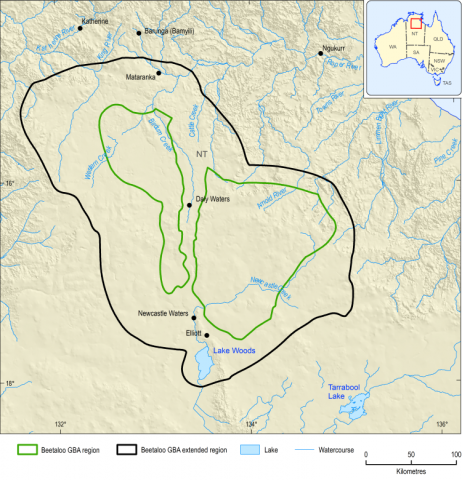Any assessment of the impact of future industries requires assumptions to be made. For unconventional gas resource development, these include overarching assumptions about: (i) the scale of development; (ii) the technologies used; (iii) the existing regulatory requirements; and (iv) the baseline knowledge of the resource, ecological and water systems. It is also assumed that the causal network correctly represents these characteristics for the assessment. Detailed assumptions about individual aspects of an assessment, such as characteristics of an activity or parameters for a particular process, are documented in the relevant node descriptions in GBA Explorer
The evaluation of potential effects requires assumptions to be made by the assessment team. These assumptions are documented in GBA Explorer and justified based on literature, GBA investigations and expert consultation. Major assumptions for the assessment for the Beetaloo GBA region are:
- Unconventional gas resource development is restricted to the clearly defined Beetaloo GBA region ( Figure 2) and adheres to existing regulations and practices, which are enforced by the relevant regulator. Development of resources adjacent to this region, including within the Beetaloo GBA extended region, is not considered. Effects of activities conducted inside the Beetaloo GBA region and supporting activities in the Beetaloo GBA extended region (transport, civil construction associated with pipelines, access roads) are considered.
- The assessment is based on current and immediately foreseeable technologies. However, unconventional gas resource development technologies and practices are continuously evolving, and so new technologies may result in different stressors on the environment.
- Development activities associated with the 5 life-cycle stages of unconventional gas resource development are correctly represented in the causal network (Huddlestone-Holmes et al., 2020): (i) exploration, (ii) appraisal, (iii) development, (iv) production and (v) rehabilitation. The assessment focuses on potential impacts associated with unconventional gas resource development activities during the exploration to production phases of the resource life cycle where the majority of activity occurs. Characteristics of activities may change throughout the life cycle, typically through the availability of shared infrastructure during the development and production stages. These differences are considered where they are expected to occur.
- The resource development scenario is a realistic estimate of the likely magnitude of future development based on areas that are more prospective for gas and estimates of the amount and rate at which gas could be produced in the future. However, it does not include commercial considerations, such as supply and demand factors and proximity to infrastructure, which are important drivers of any future development scenario. More detailed assumptions for the resource development scenario that form the foundation of the assessment are described in Section 3.4.
- The causal network adequately represents the activities and stressors associated with unconventional gas resource development, their interaction with complex ecological and hydrological systems, and their endpoints at a regional scale.
- Other drivers (climate change, other industries) are not assessed. There is an implicit assumption that those drivers are not changing processes and predicted responses to such a degree that impacts on endpoints would be materially altered.
- Links between nodes within the causal network have been correctly evaluated, including if they are possible, if they constitute a material change and if they can be mitigated. It is also assumed that confidence in those evaluations is correctly described.
- Unconventional gas resource development proponents adhere to regulations and practices in place at the time of the assessment, which are enforced by the relevant regulator.
- Where evidence to support the evaluations is not available, the precautionary principle is applied, and a higher level of concern is selected.
- Where an action may have both adverse and beneficial impacts, only adverse impacts are assessed.
- All risks to water and the environment from unconventional gas resource development are identified and risks are not accounted for more than once.
- The mitigation strategies identified are appropriate and effective.
- The confidence statements adequately reflect the uncertainty in the evaluation of links in the causal network.
Section 3.4 provides more detail on the assumptions for the resource development scenario that form the foundation of the assessment to estimate what development in the Beetaloo GBA region may look like.

